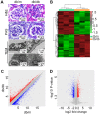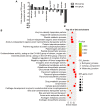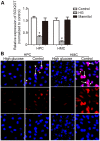Microarray analysis reveals long non‑coding RNA SOX2OT as a novel candidate regulator in diabetic nephropathy
- PMID: 30320339
- PMCID: PMC6236268
- DOI: 10.3892/mmr.2018.9534
Microarray analysis reveals long non‑coding RNA SOX2OT as a novel candidate regulator in diabetic nephropathy
Abstract
Diabetic nephropathy (DN) is a highly complex syndrome involving multiple dysregulated biological processes. Long non‑coding RNAs (lncRNAs) are now believed to have an important function in various diseases. However, their roles in DN remain largely unknown. Therefore, the present study was performed in order to investigate the lncRNAs that have a crucial role in DN. db/db mice were used as a DN model while db/m mice served as a control to search for lncRNAs which may have important roles in DN. Microarray and bioinformatics analysis gave an overview of the features of differentially expressed genes. Gene Ontology and Kyoto Encyclopedia of Genes and Genomes enrichment analysis demonstrated the typical biological alterations in DN. A co‑expression network of lncRNAs and mRNAs revealed the complex interaction pattern in DN conditions. Further data investigation indicated that SOX2‑overlapping transcript (SOX2OT), which was significantly downregulated in DN mice, may be the potentially functional lncRNA contributing to the onset of DN. The UCSC database demonstrated that SOX2OT was highly conserved in mice and humans. Additionally further study using cultured human podocytes and mesangial cells confirmed the downregulation of SOX2OT using reverse transcription‑quantitative polymerase chain reaction and fluorescence in situ hybridization. However, the cellular location of SOX2OT depended on certain cell types. Taken together, the results of the present study indicated that SOX2OT may act as an important regulator in the pathogenesis of DN by interacting with various mRNAs with critical roles in DN.
Keywords: SOX2-overlapping transcript; bioinformatics analysis; microarray analysis; diabetic nephropathy.
Figures






Similar articles
-
Whole transcriptome analysis of diabetic nephropathy in the db/db mouse model of type 2 diabetes.J Cell Biochem. 2019 Oct;120(10):17520-17533. doi: 10.1002/jcb.29016. Epub 2019 May 20. J Cell Biochem. 2019. PMID: 31106482
-
Microarray analysis of long noncoding RNA expression patterns in diabetic nephropathy.J Diabetes Complications. 2017 Mar;31(3):569-576. doi: 10.1016/j.jdiacomp.2016.11.017. Epub 2016 Dec 8. J Diabetes Complications. 2017. PMID: 28007334
-
LncRNA SOX2OT alleviates mesangial cell proliferation and fibrosis in diabetic nephropathy via Akt/mTOR-mediated autophagy.Mol Med. 2021 Jul 8;27(1):71. doi: 10.1186/s10020-021-00310-6. Mol Med. 2021. PMID: 34238205 Free PMC article.
-
Crosstalk between non-coding RNA and apoptotic signaling in diabetic nephropathy.Biochem Pharmacol. 2024 Dec;230(Pt 3):116621. doi: 10.1016/j.bcp.2024.116621. Epub 2024 Nov 13. Biochem Pharmacol. 2024. PMID: 39542182 Review.
-
Mechanism of LncRNA-MiRNA in Renal Intrinsic Cells of Diabetic Kidney Disease and Potential Therapeutic Direction.DNA Cell Biol. 2025 Jun;44(6):304-324. doi: 10.1089/dna.2025.0026. Epub 2025 Mar 21. DNA Cell Biol. 2025. PMID: 40117185 Review.
Cited by
-
Atorvastatin Regulates MALAT1/miR-200c/NRF2 Activity to Protect Against Podocyte Pyroptosis Induced by High Glucose.Diabetes Metab Syndr Obes. 2021 Apr 13;14:1631-1645. doi: 10.2147/DMSO.S298950. eCollection 2021. Diabetes Metab Syndr Obes. 2021. PMID: 33880049 Free PMC article.
-
lncRNA GAS5/miR-452-5p Reduces Oxidative Stress and Pyroptosis of High-Glucose-Stimulated Renal Tubular Cells.Diabetes Metab Syndr Obes. 2019 Dec 9;12:2609-2617. doi: 10.2147/DMSO.S228654. eCollection 2019. Diabetes Metab Syndr Obes. 2019. PMID: 31849505 Free PMC article.
-
LncRNA GAS5 reduces blood glucose levels and alleviates renal fibrosis in diabetic nephropathy by regulating the miR-542-3p/ERBB4 axis.Diabetol Metab Syndr. 2025 Jan 23;17(1):30. doi: 10.1186/s13098-025-01593-z. Diabetol Metab Syndr. 2025. PMID: 39849629 Free PMC article.
-
Identification of key lncRNAs contributing to diabetic nephropathy by gene co-expression network analysis.Sci Rep. 2019 Mar 1;9(1):3328. doi: 10.1038/s41598-019-39298-9. Sci Rep. 2019. PMID: 30824724 Free PMC article.
-
Rs9839776 Genetic Variant of lncRNA SOX2OT Contributes to Susceptibility of Acute Kidney Injury in Sepsis Patients via Regulating SOX2OT/miR-9-5p Axis.J Inflamm Res. 2025 May 8;18:6077-6089. doi: 10.2147/JIR.S508476. eCollection 2025. J Inflamm Res. 2025. PMID: 40357380 Free PMC article.
References
-
- Shang J, Wan Q, Wang X, Duan Y, Wang Z, Wei X, Zhang Y, Wang H, Wang R, Yi F. Identification of NOD2 as a novel target of RNA-binding protein HuR: Evidence from NADPH oxidase-mediated HuR signaling in diabetic nephropathy. Free Radic Biol Med. 2015;79:217–227. doi: 10.1016/j.freeradbiomed.2014.12.013. - DOI - PubMed
MeSH terms
Substances
LinkOut - more resources
Full Text Sources
Medical
Miscellaneous

